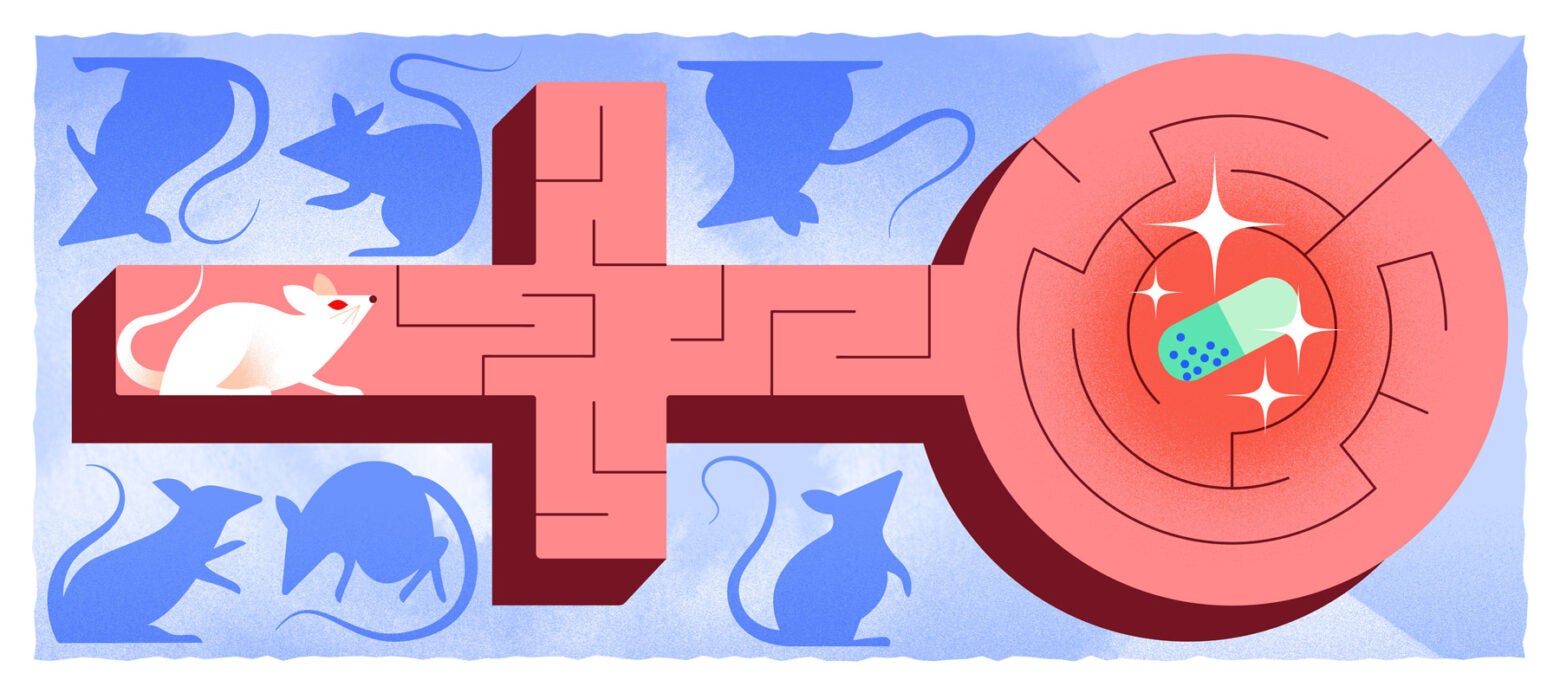
Feature
Of mice and women
Melina Kibbe never thought much about females in her studies of cardiovascular disease treatments; male animals and cells were considered the standard. “It never even dawned on me to question it,” Kibbe says. Then, when a colleague asked her one day “What about the females?” Kibbe realized she had no answer. She had never considered studying female rats in her experiments.
“I was told to control for every variable in my experiment, so I controlled for sex,” says Kibbe, now editor-in-chief of JAMA Surgery and dean of University of Virginia’s School of Medicine. She worked with her colleague, the oncology researcher Teresa Woodruff, to get a $25,000 grant to study the same promising cardiovascular treatment in female rats. Kibbe was shocked by the results: The average female needed much higher doses than her male rats to get the same clinical benefit.
This was back in 2011. More than a decade later, male animals and cells remain the dominant source of study in preclinical research, despite a 2016 mandate from the National Institutes of Health to include sex as a biological variable in both animal and human studies. There are also continued gaps in what we know about women’s health. The number of studies on women’s health still lags behind those on men in most research areas, and exceeds it only in reproductive health. Women remain less likely to be included in clinical trials—they make up only 41 percent of total clinical trial participants, according to a 2022 meta-analysis, which found even fewer female subjects in early-stage clinical trials, designed to test experimental therapies for safety and evaluate potential doses. (The analysis looked at studies conducted between 2016 and 2019; comprehensive data from more recent years is not readily available.)
Sign up for Harvard Public Health
Delivered to your inbox weekly.
Kibbe and a team of researchers this year sampled the literature regarding clinical studies in her field of vascular surgery. “It was kind of depressing,” she says. While the number of women in studies has improved over the years, they found less than five percent used any sort of sex-based analysis of disparities. Kibbe’s disappointment extends beyond her own field. Nearly a decade after the NIH policy was established, “we still have the practice of studying mostly male cells, mostly male animals.”
The unequal representation of women in trials means that “ultimately, we have this much bigger risk of not having good data about the safety of pharmaceuticals” for women patients and consumers, says Jill Fisher, professor of social medicine at the University of North Carolina, Chapel Hill. Fisher studies the experiences of subjects and researchers in Phase I trials, where safe dosing limits for later trials are established. Because men are on average larger and have different fat and hormone levels, trial phases with only men may skew the safe dosage results for women.
Historically, the most serious adverse effects of commercially available drugs have disproportionately impacted women. Legislation in the 1990s loosened restrictions on female trial participation, which brought a new era of women’s health research, but a U.S. Government Accountability Office analysis of ten drugs withdrawn from the market in 2001 found eight of them caused greater adverse reactions for women. A 2020 study found low female participation rates were still leading to the overmedication of women.
These adverse reactions are not easily prevented by adjusting dosing to the smaller average body size of females. A 2022 study found complex reasons behind different drug reactions related to sex beyond weight—including hormones, fat distribution, and immune response. Some medications, such as propofol, may actually require higher doses in females.
The inequities in data persists despite decades of efforts by federal officials to spur more research into women’s health. Last week, the White House hosted its first-ever conference on women’s health care, the culmination of more than a year of focus by the administration through its White House Initiative on Women’s Health Research. The initiative, led by First Lady Jill Biden, worked with various agencies to put hundreds of millions of dollars into the issue, with an emphasis on midlife health (when women disproportionately experience disability compared to men):
- $110 million for technology innovations to be awarded in 2025 through the NIH’s Advanced Research Projects Agency for Health, or ARPA-H;
- $27.5 million initiative from the Substance Abuse and Mental Health Services Agency;
- $500 million from the Department of Defense, announced in September as an annual commitment to research issues that disproportionately affect women, such as Alzheimer’s, rheumatoid arthritis, lupus, and certain musculoskeletal issues. In addition, the DOD and the Veterans Administration established a Military Women’s Health Research Program, aimed at improving care for the more than 200,000 women in active service and the roughly 2 million women veterans.
- $200 million from the NIH toward the groundwork of an interdisciplinary fund for women’s health research.
The government is focusing on health issues that, in addition to disproportionately affecting women, have long been relatively void of data. Eighty percent of people diagnosed with an autoimmune disease are women, for instance, but only in the last decade have researchers such as Arizona State University’s Melissa Wilson, a chromosomal biologist, started examining whether these diseases might have an evolutionary connection to pregnancy. Her work, she says, gives us a blueprint for how sex differences may influence disease.
“If we understand the root causes, then we can treat them,” Wilson says. Her study–which hypothesizes that the female immune system is amplified to protect against the drain of pregnancy–has sparked creative approaches to diseases like multiple sclerosis, for which scientists are investigating a treatment that mimics a hormone produced during pregnancy.
New funding and approaches still face substantial social hurdles: research into women’s health issues is often guided by assumptions that hormones make females behave less consistently and that the potential for pregnancy requires extreme oversight of women in trials. Fisher at the University of North Carolina has documented that female trial participants have been subjected to barriers not required of male participants, such as being required to stay at a research facility overnight to make sure they could not have sex and get pregnant. Men’s sperm also could be affected by the medications being tested, but where the women were taken off birth control and given daily pregnancy tests, the men were simply trusted not to have sex. At least two of 47 women Fisher interviewed chose to undergo permanent sterilization to be able to participate in clinical trials more easily.
Mice and men
The use of male animals at the preclinical stage, before treatments are studied on humans, is rooted in a belief that a female mouse’s estrous cycle—the four-day mouse version of a monthlong human menstrual cycle—causes too much variation in the data, particularly data about behavior. Use of male animals remain the norm despite numerous studies, such as a seminal 2014 study by Brian Prendergast, Kenneth Onishi and Irving Zucker, concluding that estrous cycles create no greater variability in female rat behavior than the variability displayed by male rates.
In fact, in some cases, says Bob Datta, a neuroscientist at Harvard University, “the science would have been cleaner had you just used females.” Datta’s lab developed MoSeq, a motion sequencing detection model for observing mice. The AI model unveils the underlying structure of body language, revealing thousands more (and more subtle) data points, exponentially more than any human could see. Datta and his colleagues found that the males displayed twice as much behavioral variability as the females. He now uses female mice for his smaller studies with only one sex. “Not only was our folk wisdom wrong, but we were making the wrong choice,” he says.
Datta’s work builds on a 2022 meta-analysis of 263 rodent studies, which concluded outright that female rat behavior was not more variable than that of males. There is less research about nonbehavioral variables like temperature or heart rate. Early findings by scientists studying those variables, like Annaliese Beery and Arthur Arnold, have been similar to those in neuroscience.
The Biden administration hopes technology innovation will accelerate closing the research gap in women’s health. ARPA-H, which received over 1,700 applications for its $110 million in grant money, in October announced awards for 23 recipients. Work funded includes developing an ovarian cancer treatment using nanoparticles and a person’s own immune system; building an endometriosis blood test; and developing an at-home medication to mitigate the risks of pre-term labor.
Change can’t come soon enough for Melissa Wilson at Arizona State, who says it can seem like “we’re just blindly feeling out there” when it comes to some of the health conditions that affect women. Scientists do have some data to draw on for tests. But, she says, “we could do better.”



